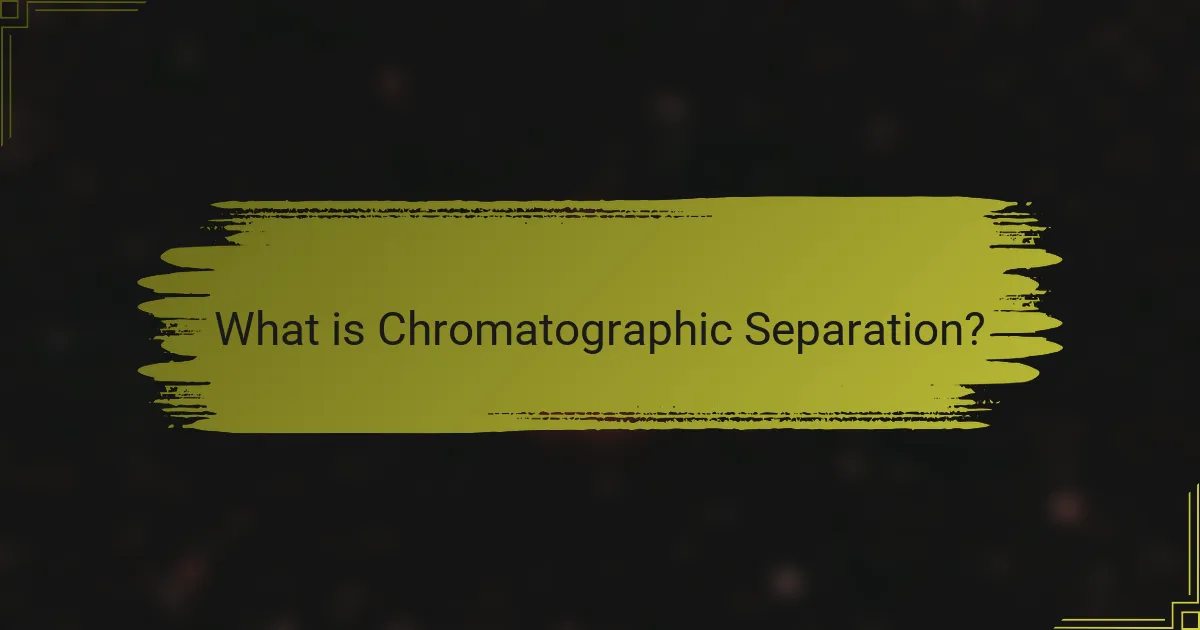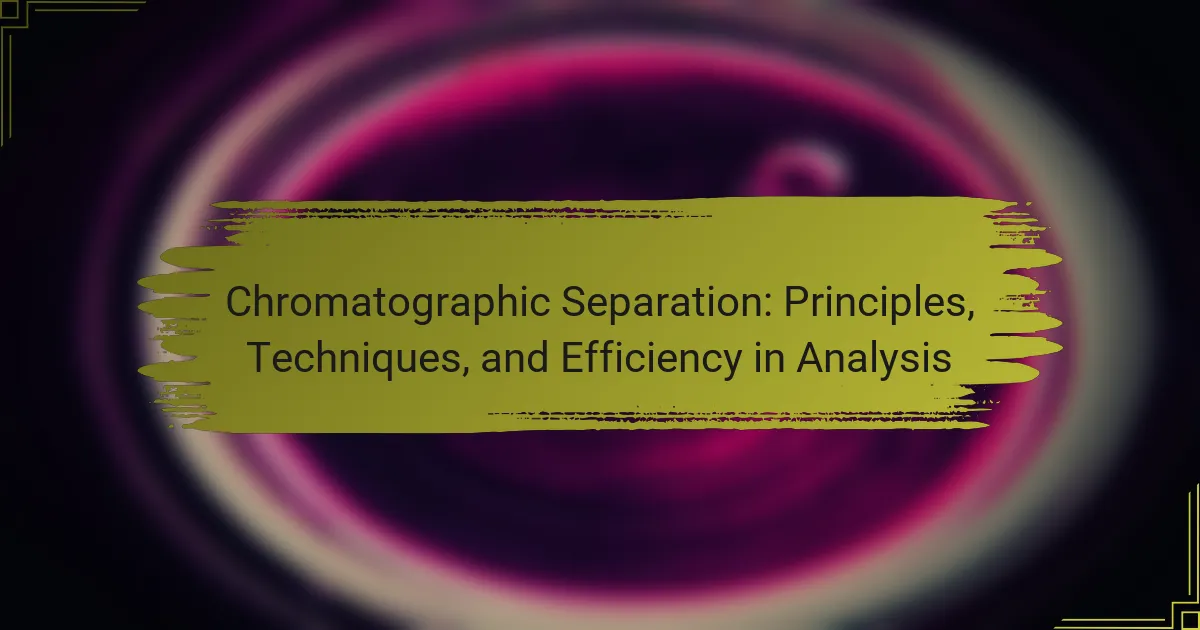
What is Chromatographic Separation?
Chromatographic separation is a technique used to separate components of a mixture. It relies on the differential distribution of compounds between a stationary phase and a mobile phase. As the mobile phase moves through or over the stationary phase, different substances travel at varying rates. This results in the separation of the mixture into its individual components. Chromatographic separation is widely used in chemistry and biochemistry for analysis and purification. Techniques like gas chromatography and liquid chromatography exemplify this method. Each technique utilizes specific conditions to optimize separation efficiency.
How does Chromatographic Separation work?
Chromatographic separation works by exploiting differences in the distribution of compounds between a stationary phase and a mobile phase. In this process, a mixture is introduced into a column containing the stationary phase. The mobile phase then carries the mixture through the column. Different compounds interact with the stationary phase to varying degrees. This leads to the separation of compounds based on their affinities. For example, some compounds may travel faster while others are retained longer. The result is that compounds exit the column at different times, allowing for their collection and analysis. This technique is widely used in chemistry and biochemistry for purifying and analyzing substances.
What are the fundamental principles of Chromatographic Separation?
Chromatographic separation relies on the principles of partitioning, adsorption, and size exclusion. Partitioning involves the distribution of compounds between two phases. One phase is stationary, while the other is mobile. Adsorption separates compounds based on their affinity for the stationary phase. Size exclusion separates based on molecular size, allowing larger molecules to pass through while retaining smaller ones. These principles enable the effective separation of complex mixtures in various analytical applications.
What role do phases play in Chromatographic Separation?
Phases play a crucial role in chromatographic separation by determining how components of a mixture interact and separate. In chromatography, there are typically two phases: the stationary phase and the mobile phase. The stationary phase is fixed in place, while the mobile phase moves through or over the stationary phase.
The interaction between these phases affects the retention time of each component. Components that interact more strongly with the stationary phase will travel slower. Conversely, components that interact more with the mobile phase will move faster. This differential movement allows for the separation of components based on their chemical properties.
The choice of phases is essential for optimizing separation efficiency. For example, in liquid chromatography, the polarity of the stationary and mobile phases can significantly influence the outcome. Studies have shown that the right phase selection can enhance resolution and reduce analysis time.
What are the main types of Chromatographic Techniques?
The main types of chromatographic techniques are gas chromatography, liquid chromatography, and thin-layer chromatography. Gas chromatography separates volatile compounds using a gas as the mobile phase. Liquid chromatography uses a liquid mobile phase to separate non-volatile compounds. Thin-layer chromatography employs a stationary phase on a flat surface for separation. Each technique has unique applications in chemical analysis. Gas chromatography is widely used for analyzing gases and volatile liquids. Liquid chromatography is essential for pharmaceuticals and biochemical analysis. Thin-layer chromatography is often used for quick qualitative analysis.
What distinguishes liquid chromatography from gas chromatography?
Liquid chromatography (LC) and gas chromatography (GC) differ primarily in their mobile phases. LC uses a liquid as the mobile phase, while GC utilizes a gas. This fundamental distinction affects the types of samples each method can analyze. LC is suitable for a wide range of compounds, including polar and thermally unstable substances. In contrast, GC is ideal for volatile and thermally stable compounds. The stationary phase also varies; LC often employs solid or liquid stationary phases, whereas GC typically uses a solid support coated with a liquid stationary phase. These differences impact separation efficiency and the methods’ applications in analytical chemistry.
How do affinity and ion-exchange chromatography differ?
Affinity chromatography utilizes specific interactions between a target molecule and a ligand attached to a stationary phase. This technique is highly selective, allowing for the purification of proteins or other biomolecules based on their binding affinity. Ion-exchange chromatography, on the other hand, separates molecules based on their charge. It employs a stationary phase with charged groups that attract oppositely charged molecules.
The main difference lies in the mechanism of separation. Affinity chromatography relies on biological interactions, while ion-exchange chromatography depends on electrostatic interactions. Affinity chromatography is often used for purifying enzymes or antibodies, whereas ion-exchange chromatography is commonly used for separating proteins and nucleic acids based on their net charge.
Both techniques are crucial in biochemical analysis and purification, but their applications and principles are distinct.
Why is Chromatographic Separation important in analysis?
Chromatographic separation is important in analysis because it allows for the effective separation of complex mixtures. This technique enables the identification and quantification of individual components within a sample. Chromatography can separate substances based on their chemical properties, such as polarity and size. This specificity enhances the accuracy of analytical results. Various forms of chromatography, like gas and liquid chromatography, are widely used in pharmaceuticals and environmental testing. Studies show that chromatographic methods can achieve high resolution and sensitivity, critical for precise measurements. For instance, high-performance liquid chromatography (HPLC) is known for its ability to separate compounds efficiently. Overall, chromatographic separation is vital for obtaining reliable data in scientific research and industry applications.
What are the applications of Chromatographic Separation in various industries?
Chromatographic separation is widely applied across various industries for analyzing and purifying substances. In the pharmaceutical industry, it is used to separate active ingredients from impurities. This ensures drug safety and efficacy. In the food industry, chromatographic techniques help in detecting additives and contaminants. They ensure compliance with safety regulations. Environmental monitoring employs chromatography to analyze pollutants in air, water, and soil. This supports regulatory compliance and public health. In the petrochemical sector, it is used for refining processes. This enhances product quality and efficiency. Additionally, chromatography is utilized in clinical laboratories for biomarker analysis. This aids in disease diagnosis and treatment monitoring. Overall, chromatographic separation plays a crucial role in quality control and regulatory compliance across multiple sectors.
How does Chromatographic Separation enhance analytical efficiency?
Chromatographic separation enhances analytical efficiency by allowing the precise separation of components within a mixture. This technique improves resolution, enabling the identification and quantification of individual substances. It minimizes sample preparation time and reduces the potential for errors. Chromatography can handle complex mixtures that would otherwise be challenging to analyze. High-throughput capabilities allow for multiple samples to be processed simultaneously. The use of various stationary and mobile phases optimizes separation based on specific properties. This adaptability contributes to faster analysis times and increased throughput. Ultimately, chromatographic separation leads to more reliable and reproducible results in analytical chemistry.
How can the efficiency of Chromatographic Separation be measured?
The efficiency of chromatographic separation can be measured using parameters such as plate number (N), height equivalent to a theoretical plate (HETP), and resolution (R). The plate number (N) quantifies the number of theoretical plates in a column. A higher plate number indicates better separation efficiency. The height equivalent to a theoretical plate (HETP) reflects the length of the column needed for one theoretical plate. A lower HETP value signifies improved efficiency. Resolution (R) measures the separation between two peaks. Higher resolution values indicate more efficient separation. These parameters are calculated using specific equations based on peak width and retention time. For instance, N can be calculated from the formula N = 16(tR/Wb)^2, where tR is the retention time and Wb is the peak width at baseline.
What metrics are used to evaluate the performance of chromatographic techniques?
The metrics used to evaluate the performance of chromatographic techniques include resolution, efficiency, selectivity, and sensitivity. Resolution measures the ability to separate two analytes. It is quantified by the difference in retention times divided by the average peak width. Efficiency is assessed by the number of theoretical plates, calculated from the peak width and height. Selectivity evaluates the ability to differentiate between different analytes based on their retention times. Sensitivity refers to the minimum concentration of an analyte that can be reliably detected. These metrics are essential for determining the effectiveness and reliability of chromatographic methods in analytical chemistry.
How does resolution impact the effectiveness of Chromatographic Separation?
Resolution directly impacts the effectiveness of chromatographic separation by determining how well different components in a mixture can be distinguished. Higher resolution leads to better separation, allowing for clearer identification of individual compounds. This clarity is crucial for accurate analysis in various applications, such as pharmaceuticals and environmental testing. Conversely, low resolution results in overlapping peaks, making it difficult to analyze components accurately. Studies have shown that a resolution of 1.5 or higher is typically required for effective separation in high-performance liquid chromatography (HPLC). Therefore, optimizing resolution is essential for enhancing the reliability and accuracy of chromatographic results.
What are the common challenges faced in Chromatographic Separation?
Common challenges in chromatographic separation include peak tailing, poor resolution, and solvent compatibility issues. Peak tailing occurs when analytes do not elute symmetrically, leading to inaccurate quantification. Poor resolution results from insufficient separation between peaks, causing difficulty in distinguishing closely eluting compounds. Solvent compatibility issues arise when the mobile phase interacts adversely with the stationary phase, affecting retention times. Additionally, column degradation can occur due to improper maintenance or harsh solvents, impacting performance. Temperature fluctuations may also lead to variability in retention times and peak shapes. These challenges can hinder the accuracy and reliability of chromatographic analysis.
What factors can affect the reproducibility of Chromatographic results?
Several factors can affect the reproducibility of chromatographic results. These include the quality of the stationary and mobile phases. Variations in their composition can lead to different retention times. Temperature fluctuations during the analysis can also impact results. Consistency in sample preparation is crucial for reproducibility. Changes in sample concentration can alter peak shapes and areas. Instrument calibration must be precise and regular to ensure accurate readings. Additionally, operator technique can introduce variability. Finally, environmental conditions such as humidity and pressure may influence the chromatographic process.
How can troubleshooting improve Chromatographic Separation outcomes?
Troubleshooting can significantly enhance Chromatographic Separation outcomes. Identifying and resolving issues such as improper solvent selection or column temperature can lead to better peak resolution. Adjusting flow rates can optimize separation efficiency. Regular maintenance of equipment ensures consistent performance and reduces variability. Monitoring system pressure can prevent potential blockages that affect results. Analyzing retention times assists in verifying method reproducibility. Implementing these troubleshooting strategies can improve both accuracy and precision in chromatographic analysis. Research shows that systematic troubleshooting can increase separation efficiency by up to 30% in various applications.
What best practices should be followed for effective Chromatographic Separation?
Effective chromatographic separation requires careful attention to several best practices. Firstly, selecting the appropriate stationary and mobile phases is crucial. This choice impacts the resolution and efficiency of separation. Secondly, optimizing flow rates enhances peak shape and reduces analysis time. Thirdly, maintaining consistent temperature during the process ensures reproducibility of results. Fourthly, sample preparation is vital; impurities can interfere with separation. Additionally, using high-quality solvents minimizes baseline noise and improves sensitivity. Regular maintenance of the chromatographic system prevents issues like blockages and leaks. Lastly, method validation is essential to confirm the reliability of results. These practices collectively enhance the effectiveness of chromatographic separation.
Chromatographic separation is a technique essential for separating components of a mixture based on their differential distribution between stationary and mobile phases. The article explores the fundamental principles of chromatographic separation, including partitioning, adsorption, and size exclusion, and details various techniques such as gas chromatography, liquid chromatography, and thin-layer chromatography. It highlights the importance of phase selection, resolution, and efficiency in analytical applications across industries like pharmaceuticals, food safety, and environmental monitoring. Additionally, the article addresses common challenges, metrics for evaluating performance, and best practices to enhance the reliability and effectiveness of chromatographic methods.
